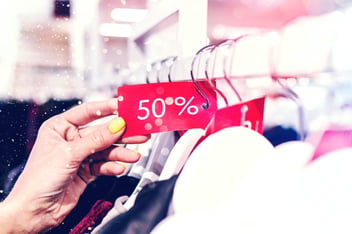🕗 3 min read ・ Shoppers expect digital promotions to be personalised, relevant, local and to integrate seamlessly with their physical and digital shopping journeys
The Evolution of Loyalty Programs in Proximity Stores

3 min read
Proximity stores face the unique challenge of limited data collection. To build customer loyalty, retailers are increasingly turning to innovative strategies, such as leveraging brand partnerships and harnessing the power of technology.
The Challenge of Limited Customer Data in Proximity Retail
In the heart of bustling cities, proximity stores like Franprix, Monoprix, and Naturalia have become essential stops for urban dwellers. These stores offer quick and convenient shopping experiences tailored to customers who prefer to shop locally. However, this convenience presents a significant challenge for retailers wanting to build customer loyalty in an environment where interactions are brief and data collection is minimal.
Unlike in larger supermarkets, where shoppers often use loyalty cards and participate in programs, customers at proximity stores tend to make spontaneous purchases without engaging in loyalty initiatives. This behaviour limits retailers' ability to gather valuable customer data, which is crucial for personalising experiences and fostering repeat business.
Leveraging Brand Partnerships for Effective Segmentation
To overcome the scarcity of direct customer data, proximity stores are collaborating closely with brands to enhance their promotional strategies. Brands possess extensive market research and consumer insights, enabling them to create detailed customer segments based on demographics, purchasing habits, and lifestyle preferences.
Camilla Ramirez, Senior Product Manager Data Marketing Platform (Personalized Promotions) at relevanC, emphasises that "By leveraging AI-driven personalisation and custom segmentation, brands can unlock new opportunities to enhance the effectiveness of their marketing campaigns." By tapping into this rich information, retailers can target promotions more effectively. For example, a beverage company might share data on consumers who prefer organic juices, allowing the store to stock relevant products and offer targeted deals.
This partnership enables proximity stores to personalise offerings and promotions, enhancing the shopping experience without relying solely on their own data collection efforts. As the ability to segment customers becomes more refined, promotions move away from generic discounts to tailored incentives that resonate with individual shoppers. Comarch indicates that retailers who personalise their offers based on customer segments achieve significantly better engagement and loyalty results.
Utilising Technology to Bridge the Data Gap
Technology plays a pivotal role in addressing the need for more customer data. Advanced analytics and machine learning algorithms can analyse transaction histories to detect patterns even from anonymous purchases. By examining factors such as purchase frequency, time of day, and basket composition, retailers can infer customer preferences and tailor promotions accordingly.
Some proximity stores have successfully leveraged data to optimise their loyalty programs. For instance, Franprix utilises relevanC's solutions to better understand customer behaviours and offer more targeted promotions. By segmenting transactional data, Franprix increased in-store purchase frequency and improved customer engagement.
Conversely, retailers fall short when they rely on overly generic promotions. Thanx points out that "offers like a simple discount on drinks for all customers have a limited impact if they do not meet the specific needs of the targeted segments." This underscores the importance of designing marketing campaigns that are adapted to maximise the potential of each customer visit.
Mobile apps have become invaluable tools, offering instant rewards, personalised deals, and seamless payment options. However, as CSNews notes, "nearly half of the customers of proximity stores believe that current mobile applications are not efficient enough." Therefore, it's crucial for retailers to provide an optimised mobile experience to retain customers and meet their expectations.
Creating Personalized and Engaging Customer Experiences
Despite limited data, proximity stores are finding innovative ways to deliver personalised experiences that resonate with customers. The use of artificial intelligence (AI) allows retailers to automate and personalise offers based on purchasing behaviours. For example, a solution like relevanC can detect a decrease in a customer's visit frequency and automatically launch a win-back campaign to bring them back to the store. According to Thanx, "This type of campaign allows for recovering 49% of inactive customers."
Gamification introduces elements like earning points, unlocking badges, and participating in challenges, adding fun to the shopping experience and incentivising repeat visits. Collaboration between retailers and brands extends to holistic marketing campaigns that align with customer interests and values.
Transparency about data usage and the benefits it brings builds trust, encouraging customers to engage more deeply. By focusing on personalisation and engagement, proximity stores transform brief transactions into meaningful interactions, fostering loyalty even in a competitive landscape with numerous shopping options.
Conclusion
By utilising advanced technological solutions like those from relevanC, retailers can segment their customers, personalise promotions, and automate specific campaigns. This approach not only increases in-store traffic but also strengthens customer relationships and maximises the value of each transaction.
In an increasingly competitive market, offering standard promotions is no longer sufficient. To build long-term customer loyalty, retailers must focus on large-scale personalisation, using intelligent tools that cater to the individual needs of each consumer. By combining technology and data, they can transform customer visits into genuine opportunities for engagement and loyalty.




Leave a Comment